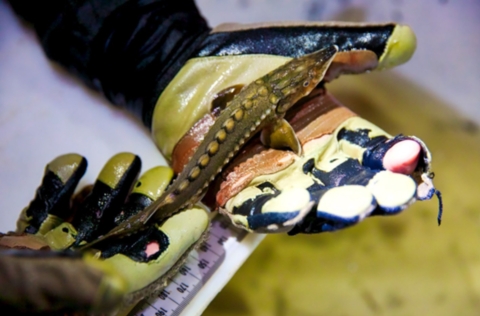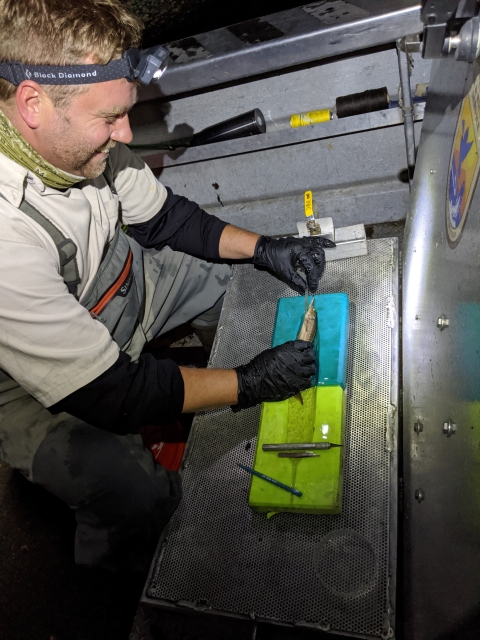States
CaliforniaGreen sturgeon life history research and monitoring, Sacramento River
The Red Bluff Fish and Wildlife Office (RBFWO) established a Green Sturgeon (Acipenser medirostris) research and monitoring program in 2001 centered on studying the effects of operating the Red Bluff Diversion Dam (RBDD). Sampling of Green Sturgeon eggs was used to determine the timing and specific locations of spawning habitat along with coarse spatial distribution patterns upstream and downstream of RBDD. Sampling of larvae by rotary trap and benthic D-nets were used to determine habitat use and drift characteristics and was originally funded by a grant through CALFED.
In 2006, the Southern Distinct Population Segment of the North American Green Sturgeon (e.g., the Sacramento River population) was first listed as threatened under the federal Endangered Species Act. This listing renewed concerns over the impacts of RBDD on this species and revitalized interest in determining life history information of the only known recurring spawning population in California at the time.
During the years 2008-2012 and through coordination with the U.S. Bureau of Reclamation (USBR) and the University of California, Davis (UCD), RBFWO restarted efforts to study the adult spawning population and their offspring relative to the impacts of the operations of the RBDD. Through the USBR, the Central Valley Project Improvement Act (CVPIA) section (b)(10) provided funding for the RBFWO to re-initiate the egg and larval studies aided by the use of acoustic telemetry data from spawning adults.
During the years 2014-2019, RBFWO research efforts have been focused on the juvenile life stage of the freshwater habitats within the upper Sacramento River for Green Sturgeon. Efforts included a feasibility study (2014-2015) to determine appropriate active capture methods for juveniles, followed by acoustic telemetry work (2016-2019) to determine residency, transition cues and migration rates from the fresh to brackish waters of the Sacramento River.
Most recently (2019, 2021-present), in-river residency habitat use research has been initiated to determine the physical characteristics of juvenile rearing habitats, coupled with behavioral data collection through the use of a 2-dimensional acoustic arrays. Some data have been collected and are in the process of analyses. Funding will be needed to complete this project by adding additional years of data collection, processing and analyses and modeling to complete this research phase. The goal of this project will be to qualify and quantify juvenile rearing habitat in the Sacramento River and to be able to determine if, and how much, comparable habitat exists within other Central Valley rivers. Stay tuned for updates!
Acoustic telemetry detection data can be downloaded from NOAA Fisheries Southwest Fisheries Science Center’s Environmental Research Division Data Access Program, JSATS California Fish Tracking website: https://oceanview.pfeg.noaa.gov/erddap/tabledap/FED_JSATS_detects.html.
Data are also available through the Central Valley Enhanced Acoustic Tagging Project ShinyApp: https://oceanview.pfeg.noaa.gov/shiny/FED/telemetry/
The results of the collaborative Green Sturgeon research efforts referenced above can be found in multiple USFWS technical reports (available upon request, email redbluff@fws.gov) and peer-reviewed publications on adult spawners, their eggs, larvae and juveniles as cited below:
Brown, K. 2007. Evidence of spawning by green sturgeon, Acipenser medirostris, in the upper Sacramento River, California. Environmental Biology of Fishes, 79, 297–303. https://doi.org/10.1007/s10641-006-9085-5
Gruber, J. J., W. R. Poytress, C. E. Praetorius, and D. J. Ryan. 2017. 2014 and 2015 juvenile green sturgeon capture feasibility study. Red Bluff Fish and Wildlife Office, Anadromous Fish Restoration Program, U.S. Fish and Wildlife Service, Red Bluff, CA, USA.
Gruber, J. J., L. C. Polansky and W. R. Poytress. 2022. 2016-2019 Upper Sacramento River Juvenile Green Sturgeon Outmigration Investigation. Red Bluff Fish and Wildlife Office, Anadromous Fish Restoration Program, U.S. Fish and Wildlife Service, Red Bluff, CA, USA.
Poytress, W. R., L. C. Polansky and J. J. Gruber. 2024. Transitional Strategies of Juvenile Green Sturgeon from a Riverine to a Brackish Water Environment. Journal of Applied Ichthyology. Volume 2024, Article ID 6637511, 20 pages. https://doi.org/10.1155/2024/6637511
Poytress, W. R., J. J. Gruber, J. P. Van Eenennaam, and M. Gard. 2015. Spatial and temporal distribution of spawning events and habitat characteristics of Sacramento River green sturgeon. Transactions of the American Fisheries Society, 144, 1129–1142. https://doi.org/10.1080/00028487.2015.1069213
Thomas, M. J., M. L. Peterson, E. D. Chapman, A. R. Hearn, G. P. Singer, R. D. Battleson, and A. P. Klimley. 2014. Behavior, movements, habitat use of adult green sturgeon, Acipenser medirostris, in the upper Sacramento River. Environmental Biology of Fishes, 97, 133–146. https://doi.org/10.1007/s10641-013-0132-8
Thomas M. J., M. L. Peterson, E. D. Chapman, N. A. Fangue, and A. P. Klimley. 2019. Individual habitat usage patterns and behavior of acoustically-tagged juvenile green sturgeon in the Sacramento-San Joaquin Delta. Environ Biol Fish102:1025–1037
Steel A. E., M. J. Thomas, A. P. Klimley. 2018. Reach specific use of spawning habitat by adult green sturgeon (Acipenser medirostris) under different operation schedules at Red Bluff Diversion Dam. J Applied Ichthyology 35:1–8
Wyman, M. T., M. J. Thomas, R. R. McDonald, A. R. Hearn, R. D. Battleson, E. D. Chapman, and A. P. Klimley. 2017. Fine-scale habitat selection of green sturgeon (Acipenser medirostris) within three spawning locations in the Sacramento River, California. Canadian Journal of Fisheries and Aquatic Sciences. https://doi.org/10.1139/cjfas-2017-0072
For additional information or technical reports not listed above, please email redbluff@fws.gov



